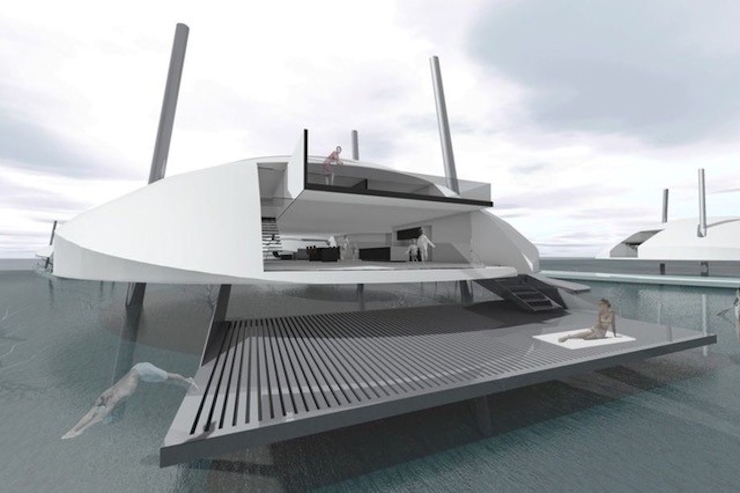
Fane Lozman’s plans to develop his water community in Florida have been delayed. But for good reason.
He just won his second Supreme Court case. He is the first person to argue and win two different cases in the Supreme Court. The 8-1 decision handed down by the Supreme Court on June 18, 2018, involved free speech rights, specifically with how elected officials conduct themselves with citizens during town hall meetings.
But it was his first case that won him notoriety, and eventually, the opportunity to purchase waterfront land. He won his first case in 2013 with a 7-2 decision that ruled his 60-foot floating home was “not a vessel” and was therefore illegally removed from its marina and destroyed by the city of Riviera Beach. This case set precedent that floating homes are not subject to maritime law and, as the Miami Herald reported, Lozman “saved other people’s homes from being taken via eminent domain for a new private marina in Riviera Beach, and he was able to keep the public marina out of private hands.”
The Floating Homes Association provided documentation as a friend of the court that helped Fane win his case.
After the first Supreme Court case, Lozman and some prominent partners purchased property in a lagoon off Singer Island in Florida. “There was so much media coverage after the case,” Fane recalls, “The people that owned the property were very wealthy and they felt sorry for me. The media coverage from the case helped get me into this.” Lozman now owns 25 acres of submerged land in Singer Island. His partners own 50 surrounding acres.
The second Supreme court case has been “a 4,000-5,000-hour process,” according to Lozman, “so it’s delayed my plans for developing my waterfront community.”
There have been other setbacks as well. After Fane purchased a 60’x 24’ floating home from a friend and towed it to his property, the home was vandalized with “poop” in the living room. A few weeks later, a person in a nearby condo witnessed lights on in the home and the next day, the floating home sunk on the property. Lozman tried to refloat it, but it stuck in the mud. “The hull was 49 years old. It was fiberglass over plywood. It ultimately suffered a catastrophic hull failure and had to be demo’d.” While he can’t be 100% sure this was a deliberate act to destroy the home, Lozman saw it as a “wake up call” for how sensitive floating homes can be to vandalism.
And then there are the challenges of the property and conditions in the area as well. Only 15-20% of the property is deep enough for floating homes. The water depth, combined with the vandalism threats, gave him pause. “Perhaps a stilt home community could be a superior solution than a traditional floating home.” He has researched several designs and has concluded his design would need to be a combination. He’d start with a “tidal house” design used in British Columbia. (like the one in the accompanying photo). “They look like flying saucers on 3 stilts,” he notes. “The curbed dome shape could take a category 5 hurricane hit.” While the dome curve is good for wind loading, it may weigh a couple of hundred thousand pounds, so it won’t be supported by just three poles. The homes would need to be on top of reinforced concrete.
“Up north, they are built on conventional pilings, but we’d need something more substantial to survive the high winds here. We’d need to modify this design onto a foam core wrapped concrete float. An Aquamaison-type barge typically requires about 6-8 feet of water, but there’s not enough depth here to accommodate that. There’s an IMS float they use up in Washington that could work.” Floats made by International Marine Floatation Systems feature a reinforced concrete shell with a core of expanded polystyrene. “They are unsinkable,” says Fane. His final designs are still in process.
They will be expensive homes, but 8 miles south is Mar a Lago, where $40-80 million homes are not uncommon. His proposed homes would “go for 4 million bucks. Relatively reasonable when you consider the penthouse condos around here go for around $10 million. Even the cheapest condos are $1.5 million. Either way, we will build stilt homes or conventional homes. The backup plan would be to bring in a thousand truckloads of rock if they give us a hard time permitting the water structures, and we’d just build conventional homes.”
Fane notes: “Ultimately, you can’t take away property development rights in Florida without compensation. Around here, 1/4 acre property goes for $1.3 million on the land adjacent to us.” Buildable lots on the upland go for $3 million an acre. “If they don’t want it developed, they can write a check for a couple hundred million for those rights. But in reality, they can’t afford to pay for it, and they’re not going to pay for it. The state sold it specifically to be developed. We feel comfortable that it will be developed and these people that whine can’t really do anything about it.”